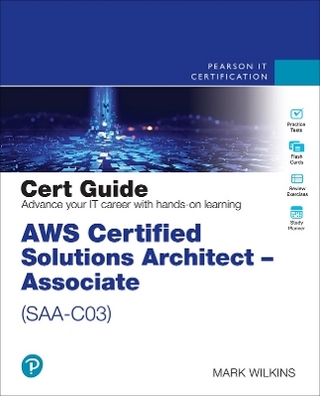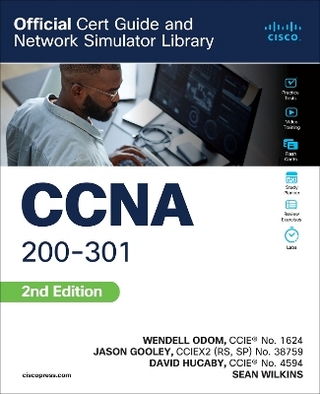
CCNA Certification
Prentice Hall
978-0-13-086185-6 (ISBN)
- Titel ist leider vergriffen;
keine Neuauflage - Artikel merken
For courses in Cisco certification.
CCNA certification is key for students looking to broaden their career opportunities—and this essential guide follows the CCNA exam objectives to increase students' chances for passing the exam. Myhre introduces networking using the OSI model, and continues through the LAN/WAN environment defining how Cisco products meet the diverse needs of small to enterprise-wide companies. Throughout, students are treated as if they were given the task of setting up a small routed network with connectivity to the Internet.
Robert Myrhe is a consultant specializing in Cisco and Microsoft networking, based in Minneapolis, MN. Myrhe is also a Cisco trainer for Learning Tree International.
1. Introduction to Networking and the OSI Model.
Introduction to Networking. The OSI Model. Why Use a Layered Model? How Does a Model Work? Application Layer (Layer 7). Presentation Layer (Layer 6). Session Layer (Layer 5). Transport Layer (Layer 4). Network Layer (Layer 3). Data Link Layer (Layer 2). Physical Layer (Layer 1). Data Encapsulation Using the OSI Model.
2. LAN Technologies.
Ethernet. CSMA/CD. Physical Layer. Data Link Layer. Types of Ethernet. Token Ring. Physical Layer. Data Link Layer. Fault Tolerance. FDDI. Physical and Data Link Layers. ATM. Physical and Data Link Layers. LAN Emulation (LANE).
3. Repeaters, Switches, Bridges, and Routers.
LAN Segmentation. Repeaters. Bridges. Routers. Switches. Virtual LANs, or VLANs.
4. TCP/IP.
The OSI Model versus the TCP/IP Model. Internet Protocol (IP). Address Resolution Protocol (ARP). Internet Control Message Protocol (ICMP). Transmission Control Protocol (TCP). User Datagram Protocol (UDP). Application Layer Protocols. File Transfer Protocol (FTP). Trivial File Transfer Protocol (TFTP). Telnet. Simple Network Management Protocol (SNMP). Other Protocols and Applications.
5. Introduction to Cisco Routers.
Cisco Products Overview. Switches-Catalyst 1900 Series. Switches-Catalyst 2820 Series. Switches-Catalyst 2900 Series. Switches-Catalyst 5000 Series. Routers-Cisco 700 Series. Routers-Cisco 1600 Series. Routers-Cisco 2600 Series. Routers-Cisco 3600 Series. Routers-Cisco 4000 Series. Routers-Cisco 7000 Series. Learning More. Cisco 2500 Series Access Routers. Router Architecture. IOS. Configuring the Cisco Router. Configuration Script Install. Manual Configuration Using CLI. Connecting Routers to Each Other.
6. TCP/IP Addressing.
Binary Counting. Addressing Principles. Classes of Addresses. Class A. Class B. Class C. Class D and Class E. Class Summary. Subnet Masks. Assigning TCP/IP Addresses. Setting Up Cisco Routers.
7. TCP/IP Subnetting.
What Is Subnetting? Why Subnet? Finding the Subnet Mask. Step #1. Step #2. Step #3. Step #4. Finding the Number of Hosts/Subnets. Finding the Number of Subnets. Finding the Number of Hosts per Subnet. Populating the Subnets. Calculating the Subnet Addresses. Calculating the Host Ids. Supernetting. Configuring IC, Inc. Step #1. Step #2. Step #3. Router 1. Router 2. Router 3.
8. Static TCP/IP Routing.
Static Routing Concepts. Configuring Routers for Static Routes. Router 1. Router 2. Router 3. Troubleshooting. Default Routing.
9. Dynamic Routing.
Routed versus Routing Protocols. Interior versus Exterior Routing Protocols. Differences Among Interior Gateway Protocols. Distance Vector. Link State. Classful versus Classless. Routing Information Protocol. Additional RIP Knowledge. Interior Gateway Routing Protocol. Multiprotocol Routing (MPR).
10. Managing the Cisco Router.
Disasters Can Occur. The Boot Process. Working with the IOS Image. Working with the Configuration Files. Lost Passwords.
11. IPX/SPX.
IPX/SPX Model. Network Addressing. Encapsulation. Configuring Cisco Routers. Service Advertisement Protocol. Get Nearest Server.
12. AppleTalk.
AppleTalk Model. Network Addressing. Putting It All Together. Configuring Cisco Routers.
13. Security with Access Lists.
Basics of Access Lists. AppleTalk Access Lists. IPX Access Lists. Standard Access Lists. Extended Access Lists. Sap Filters. IP Access Lists. Standard Access Lists. Extended Access Lists.
14. WAN Technologies.
How Serial Links Work. HDLC. PPP. ISDN. BRI. PRI. Frame Relay. Configuring Frame Relay on Cisco Routers. Subinterfaces.
15. Extra Features of the Cisco Router.
Cisco Discovery Protocol. Show Commands. Debugging. Telnet. Logging. Usernames.
Appendix A.
Appendix B.
Appendix C.
Index.
| Erscheint lt. Verlag | 6.1.2000 |
|---|---|
| Verlagsort | Upper Saddle River |
| Sprache | englisch |
| Maße | 188 x 241 mm |
| Gewicht | 1248 g |
| Themenwelt | Mathematik / Informatik ► Informatik ► Netzwerke |
| Mathematik / Informatik ► Informatik ► Web / Internet | |
| Informatik ► Weitere Themen ► Zertifizierung | |
| ISBN-10 | 0-13-086185-5 / 0130861855 |
| ISBN-13 | 978-0-13-086185-6 / 9780130861856 |
| Zustand | Neuware |
| Haben Sie eine Frage zum Produkt? |
aus dem Bereich


